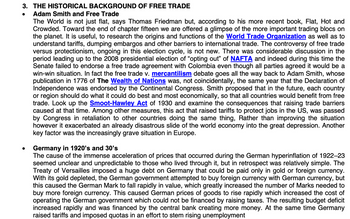
A. Did you follow the still ongoing discussion about free trade in the recent election cycle? Do you think
that the USA is tending toward a mercantilist approach and likely to impose restrictions on foreign trade
over the next few years?
B. Do you agree or disagree with Adam Smith that we are better off with some form of free trade, than
would be the case if each country raised or lowered tariffs based on its own economic needs and political
philosophy? Provide a logical reason for your answer.
Not at all Somewhat Completely
1 2 3 4 5 6 7 8 9 10
C. Thomas Freedman made the following statement in the “World is Flat”. He maintains that technology
makes it possible to compete with, or collaborate with anyone, anywhere in the world. Globalization, he
argued is both inevitable and desirable. The winners says Freedman, will be the countries and
companies that can respond quickly to change and that the loser will be those who are slow to do so.
“Whatever our political and philosophical points of view we may have little option but to adapt to the
global economy.” Do you agree or disagree?
What is the reason for your answer?


Step by stepSolved in 5 steps

- Morocco and Tunisia both have Mediterranean climates that are excellent for producing/harvesting green beans and tomatoes. In Morocco it takes two hours for each worker to harvest green beans and two hours to harvest a tomato. Tunisian workers need only one hour to harvest the tomatoes but four hours to harvest green beans. Assume there are only two workers, one in each country, and each works 40 hours a week. a. Identify which country has the absolute advantage in green beans and which country has the absolute advantage in tomatoes. b. Identify which country has comparative advantage in which product. c. Initially each country used ½ of the workers in producing green beans and tomatoes. If each country specializes based on comparative advantage find an exchange mechanism so that both gain from trade.arrow_forwardone of your relaties suggests to you that our country should stop trading with other countries because imports take away jobs and lower our national well-being. How would you try ot convince him that this is probably not the right way to look at international trade and its effects on the country?arrow_forwardTariffs can help or hurt the economy explain the Hawley-Smoot Act with this in mind.arrow_forward
- Which of the following is proof that international trade is beneficial? O the fact that different regions in the United States specialize in different products O the international trade in exotic products O the sheer volume of trade between very different nationsswer text provided. O the concept of absolute advantagearrow_forwardWhat were some of the reasons for the decline in the import-substituting industrialization strategy in favor of a strategy that promotes open trade? O High rates of effective protection allowed industries to survive when their cost of production was three to four times higher than the price of the imports they replaced. O Protectionist policies had a negative effect on incentives, which led to rent-seeking or corruption in some developing countries. O Countries pursuing import substitution were not catching up with advanced countries. O All of the above.arrow_forward96 FL If Honduras and Guatemala each specialize in producing the good in which they have a comparative advantage and then trade with one another original PPF. O both countries would end up on a point to the right of their O both countries would end up at a point to the left of their one country would remain on its original PPF, while the other country would end up on a point to the right of its O both countries would end up on a different point on their Unit 7- Chapter 1...xlsx Unit 7- Chapter 1..xlsx O Topic 2 (2).docx O Topic 2 (1).docx 11:09 PM 73°F SUI prt sc delete f12 pus backspace -> unu Bock enter pause T shift alt ctrlarrow_forward

 Principles of Economics (12th Edition)EconomicsISBN:9780134078779Author:Karl E. Case, Ray C. Fair, Sharon E. OsterPublisher:PEARSON
Principles of Economics (12th Edition)EconomicsISBN:9780134078779Author:Karl E. Case, Ray C. Fair, Sharon E. OsterPublisher:PEARSON Engineering Economy (17th Edition)EconomicsISBN:9780134870069Author:William G. Sullivan, Elin M. Wicks, C. Patrick KoellingPublisher:PEARSON
Engineering Economy (17th Edition)EconomicsISBN:9780134870069Author:William G. Sullivan, Elin M. Wicks, C. Patrick KoellingPublisher:PEARSON Principles of Economics (MindTap Course List)EconomicsISBN:9781305585126Author:N. Gregory MankiwPublisher:Cengage Learning
Principles of Economics (MindTap Course List)EconomicsISBN:9781305585126Author:N. Gregory MankiwPublisher:Cengage Learning Managerial Economics: A Problem Solving ApproachEconomicsISBN:9781337106665Author:Luke M. Froeb, Brian T. McCann, Michael R. Ward, Mike ShorPublisher:Cengage Learning
Managerial Economics: A Problem Solving ApproachEconomicsISBN:9781337106665Author:Luke M. Froeb, Brian T. McCann, Michael R. Ward, Mike ShorPublisher:Cengage Learning Managerial Economics & Business Strategy (Mcgraw-...EconomicsISBN:9781259290619Author:Michael Baye, Jeff PrincePublisher:McGraw-Hill Education
Managerial Economics & Business Strategy (Mcgraw-...EconomicsISBN:9781259290619Author:Michael Baye, Jeff PrincePublisher:McGraw-Hill Education





